Took me a while, but here is my code:
Sub SubOutput()
'Declarations.
Dim WksInput As Worksheet
Dim WksOutput As Worksheet
Dim RngInputFirstCell As Range
Dim RngOutputFirstCell As Range
Dim BytOffset As Byte
Dim RngRange01 As Range
Dim RngTarget As Range
Dim BytWholeCalendar As Byte
Dim DatFirstDate As Date
Dim DatLastDate As Date
Dim IntCounter01 As Integer
'Setting variables.
Set WksInput = Sheets("Input") 'put here the name of the worksheet with input data
Set WksOutput = Sheets("Output") 'put here the name of the worksheet with the output data
Set RngInputFirstCell = WksInput.Range("A1") 'put here the top left cell of the input data (the one with value Dates1)
Set RngOutputFirstCell = WksOutput.Range("A1") 'put here the top left cell of the output data (the one with value Dates)
'Asking what days are to be reported.
BytWholeCalendar = MsgBox("Do you need the output to report data for every day?", vbYesNoCancel, "Report every day?")
'In case of no answer, the subroutine is terminated.
If BytWholeCalendar <> 6 And BytWholeCalendar <> 7 Then
Exit Sub
End If
'Typing "Dates" in RngOutputFirstCell.
RngOutputFirstCell = "Dates"
'Covering the entire input.
Do Until RngInputFirstCell.Offset(0, BytOffset * 2) = ""
'Setting first part of the range to be copied (dates).
Set RngRange01 = WksInput.Range(RngInputFirstCell.Offset(1, BytOffset * 2), WksInput.Cells(WksInput.Rows.Count, RngInputFirstCell.column + BytOffset * 2).End(xlUp))
'Setting the range where to paste the dates.
Set RngTarget = WksOutput.Cells(WksOutput.Rows.Count, RngOutputFirstCell.column).End(xlUp).Offset(1, 0)
Set RngTarget = RngTarget.Resize(RngRange01.Rows.Count)
'Pasting the dates.
RngTarget.Value = RngRange01.Value
'Copying the result name.
RngOutputFirstCell.Offset(0, BytOffset + 1).Value = RngInputFirstCell.Offset(0, BytOffset * 2 + 1).Value
'Setting BytOffset to cover the next rows of data.
BytOffset = BytOffset + 1
Loop
'Editing the dates according to BytWholeCalendar.
Select Case BytWholeCalendar
Case Is = 6
'Setting variables.
DatFirstDate = Excel.WorksheetFunction.Min(WksOutput.Range(RngOutputFirstCell.Offset(1, 0), RngOutputFirstCell.End(xlDown)))
DatLastDate = Excel.WorksheetFunction.Max(WksOutput.Range(RngOutputFirstCell.Offset(1, 0), RngOutputFirstCell.End(xlDown)))
IntCounter01 = 1
'Clearing dates.
WksOutput.Range(RngOutputFirstCell.Offset(1, 0), RngOutputFirstCell.End(xlDown)).ClearContents
'Filling dates.
For DatFirstDate = DatFirstDate To DatLastDate
RngOutputFirstCell.Offset(IntCounter01, 0).Value = DatFirstDate
IntCounter01 = IntCounter01 + 1
Next DatFirstDate
Case Is = 7
'Sorting output dates.
With WksOutput.Sort
.SortFields.Clear
.SortFields.Add Key:=RngOutputFirstCell, _
SortOn:=xlSortOnValues, _
Order:=xlAscending, _
DataOption:=xlSortTextAsNumbers
.SetRange Range(RngOutputFirstCell, RngOutputFirstCell.End(xlDown))
.Header = xlYes
.MatchCase = False
.Orientation = xlTopToBottom
.SortMethod = xlPinYin
.Apply
End With
'Marking unique dates.
Set RngTarget = WksOutput.Range(RngOutputFirstCell.Offset(1, 1), RngOutputFirstCell.End(xlDown).Offset(0, 1))
RngTarget.FormulaR1C1 = "=IF(RC[-1]=R[1]C[-1],"""",""X"")"
RngTarget.Value = RngTarget.Value
'Sorting output dates by unique values.
With WksOutput.Sort
.SortFields.Clear
.SortFields.Add Key:=RngOutputFirstCell.Offset(0, 1), _
SortOn:=xlSortOnValues, _
Order:=xlAscending, _
DataOption:=xlSortTextAsNumbers
.SetRange Range(RngOutputFirstCell.Offset, RngOutputFirstCell.End(xlDown).Offset(0, 1))
.Header = xlYes
.MatchCase = False
.Orientation = xlTopToBottom
.SortMethod = xlPinYin
.Apply
End With
'Clearing double dates.
With WksOutput.Range(RngOutputFirstCell.End(xlDown), RngOutputFirstCell.Offset(0, 1).End(xlDown).Offset(1, 0))
.ClearContents
.ClearFormats
End With
End Select
'Setting RngTarget to cover the results' part of the output.
Set RngTarget = WksOutput.Range(RngOutputFirstCell.Offset(1, 1), RngOutputFirstCell.End(xlDown).Offset(0, 1))
Set RngTarget = RngTarget.Resize(, BytOffset)
RngTarget.FormulaR1C1 = "=VLOOKUP(RC" & RngOutputFirstCell.column & ",OFFSET(INDIRECT(""" & WksInput.Name & "!R" & RngInputFirstCell.Row + 1 & "C""" & " & MATCH(R" & RngOutputFirstCell.Row & "C," & WksInput.Name & "!" & WksInput.Range(RngInputFirstCell, RngInputFirstCell.End(xlToRight)).Address(, , xlR1C1) & ",0) + " & RngInputFirstCell.column - 1 & ",FALSE),0,-1,5000,2),2,FALSE)"
'Typing in RngTarget the formula.
'RngTarget.FormulaR1C1 = "=IFERROR(VLOOKUP(RC" & RngOutputFirstCell.column & ",OFFSET(INDIRECT(""" & WksInput.Name & "!R" & RngInputFirstCell.Row + 1 & "C""" & " & MATCH(R" & RngOutputFirstCell.Row & "C," & WksInput.Name & "!" & WksInput.Range(RngInputFirstCell, RngInputFirstCell.End(xlToRight)).Address(, , xlR1C1) & ",0) + " & RngInputFirstCell.column - 1 & ",FALSE),0,-1,5000,2),2,FALSE),0)"
'Transforming formulas into values.
'RngTarget.Value = RngTarget.Value
'Setting RngTarget to select the output data.
Set RngTarget = RngTarget.Offset(0, -1).Resize(, RngTarget.Columns.Count + 1)
'Formatting.
With RngTarget
.HorizontalAlignment = xlCenter
.VerticalAlignment = xlBottom
.Borders(xlDiagonalDown).LineStyle = xlNone
.Borders(xlDiagonalUp).LineStyle = xlNone
.Borders(xlInsideHorizontal).LineStyle = xlNone
With .Borders(xlEdgeLeft)
.LineStyle = xlContinuous
.ColorIndex = xlAutomatic
.TintAndShade = 0
.Weight = xlMedium
End With
With .Borders(xlEdgeTop)
.LineStyle = xlContinuous
.ColorIndex = xlAutomatic
.TintAndShade = 0
.Weight = xlMedium
End With
With .Borders(xlEdgeBottom)
.LineStyle = xlContinuous
.ColorIndex = xlAutomatic
.TintAndShade = 0
.Weight = xlMedium
End With
With .Borders(xlEdgeRight)
.LineStyle = xlContinuous
.ColorIndex = xlAutomatic
.TintAndShade = 0
.Weight = xlMedium
End With
With .Borders(xlInsideVertical)
.LineStyle = xlContinuous
.ColorIndex = xlAutomatic
.TintAndShade = 0
.Weight = xlMedium
End With
End With
'Setting RngTarget to select the output labels.
Set RngTarget = RngTarget.Offset(-1, 0).Resize(1)
'Formatting.
With RngTarget
.HorizontalAlignment = xlCenter
.VerticalAlignment = xlBottom
.Borders(xlDiagonalDown).LineStyle = xlNone
.Borders(xlDiagonalUp).LineStyle = xlNone
.Borders(xlInsideHorizontal).LineStyle = xlNone
With .Borders(xlEdgeLeft)
.LineStyle = xlContinuous
.ColorIndex = xlAutomatic
.TintAndShade = 0
.Weight = xlMedium
End With
With .Borders(xlEdgeTop)
.LineStyle = xlContinuous
.ColorIndex = xlAutomatic
.TintAndShade = 0
.Weight = xlMedium
End With
With .Borders(xlEdgeBottom)
.LineStyle = xlContinuous
.ColorIndex = xlAutomatic
.TintAndShade = 0
.Weight = xlMedium
End With
With .Borders(xlEdgeRight)
.LineStyle = xlContinuous
.ColorIndex = xlAutomatic
.TintAndShade = 0
.Weight = xlMedium
End With
With .Borders(xlInsideVertical)
.LineStyle = xlContinuous
.ColorIndex = xlAutomatic
.TintAndShade = 0
.Weight = xlMedium
End With
End With
RngTarget.EntireColumn.AutoFit
Debug.Print "REPORT"; " | "
Debug.Print "WksInput.Parent.Name = WksOutput.Parent.Name ? "; WksInput.Parent.Name = WksInput.Parent.Name; " | "
Debug.Print "WksInput.Name ? "; WksInput.Name; " | "
Debug.Print "RngInputFirstCell.Address ? "; RngInputFirstCell.Address; " | "
Debug.Print "RngInputFirstCell.Value ? "; RngInputFirstCell.Value; " | "
Debug.Print "RngInputFirstCell.Formula ? "; RngInputFirstCell.Formula; " | "
Debug.Print "RngInputFirstCell.Offset(1,0).Address ? "; RngInputFirstCell.Offset(1, 0).Address; " | "
Debug.Print "RngInputFirstCell.Offset(1,0).Value ? "; RngInputFirstCell.Offset(1, 0).Value; " | "
Debug.Print "RngInputFirstCell.Offset(1,0).Formula ? "; RngInputFirstCell.Offset(1, 0).Formula; " | "
Debug.Print "RngInputFirstCell.Offset(0,1).Address ? "; RngInputFirstCell.Offset(0, 1).Address; " | "
Debug.Print "RngInputFirstCell.Offset(0,1).Value ? "; RngInputFirstCell.Offset(0, 1).Value; " | "
Debug.Print "RngInputFirstCell.Offset(0,1).Formula ? "; RngInputFirstCell.Offset(0, 1).Formula; " | "
Debug.Print "RngInputFirstCell.Offset(1,1).Address ? "; RngInputFirstCell.Offset(1, 1).Address; " | "
Debug.Print "RngInputFirstCell.Offset(1,1).Value ? "; RngInputFirstCell.Offset(1, 1).Value; " | "
Debug.Print "RngInputFirstCell.Offset(1,1).Formula ? "; RngInputFirstCell.Offset(1, 1).Formula; " | "
Debug.Print "RngInputFirstCell.Offset(91,0).Address ? "; RngInputFirstCell.Offset(91, 0).Address; " | "
Debug.Print "RngInputFirstCell.Offset(91,0).Value ? "; RngInputFirstCell.Offset(91, 0).Value; " | "
Debug.Print "RngInputFirstCell.Offset(91,0).Formula ? "; RngInputFirstCell.Offset(91, 0).Formula; " | "
Debug.Print "RngInputFirstCell.Offset(91,1).Address ? "; RngInputFirstCell.Offset(91, 1).Address; " | "
Debug.Print "RngInputFirstCell.Offset(91,1).Value ? "; RngInputFirstCell.Offset(91, 1).Value; " | "
Debug.Print "RngInputFirstCell.Offset(91,1).Formula ? "; RngInputFirstCell.Offset(91, 1).Formula; " | "
Debug.Print "WksOutput.Name ? "; WksOutput.Name; " | "
Debug.Print "RngOutputFirstCell.Address ? "; RngOutputFirstCell.Address; " | "
Debug.Print "RngOutputFirstCell.Value ? "; RngOutputFirstCell.Value; " | "
Debug.Print "RngOutputFirstCell.Formula ? "; RngOutputFirstCell.Formula; " | "
Debug.Print "RngOutputFirstCell.Offset(1,0).Address ? "; RngOutputFirstCell.Offset(1, 0).Address; " | "
Debug.Print "RngOutputFirstCell.Offset(1,0).Value ? "; RngOutputFirstCell.Offset(1, 0).Value; " | "
Debug.Print "RngOutputFirstCell.Offset(1,0).Formula ? "; RngOutputFirstCell.Offset(1, 0).Formula; " | "
Debug.Print "RngOutputFirstCell.Offset(0,1).Address ? "; RngOutputFirstCell.Offset(0, 1).Address; " | "
Debug.Print "RngOutputFirstCell.Offset(0,1).Value ? "; RngOutputFirstCell.Offset(0, 1).Value; " | "
Debug.Print "RngOutputFirstCell.Offset(0,1).Formula ? "; RngOutputFirstCell.Offset(0, 1).Formula; " | "
Debug.Print "RngOutputFirstCell.Offset(1,1).Address ? "; RngOutputFirstCell.Offset(1, 1).Address; " | "
Debug.Print "RngOutputFirstCell.Offset(1,1).Value ? "; RngOutputFirstCell.Offset(1, 1).Value; " | "
Debug.Print "RngOutputFirstCell.Offset(1,1).Formula ? "; RngOutputFirstCell.Offset(1, 1).Formula; " | "
Debug.Print "RngOutputFirstCell.Offset(91,0).Address ? "; RngOutputFirstCell.Offset(91, 0).Address; " | "
Debug.Print "RngOutputFirstCell.Offset(91,0).Value ? "; RngOutputFirstCell.Offset(91, 0).Value; " | "
Debug.Print "RngOutputFirstCell.Offset(91,0).Formula ? "; RngOutputFirstCell.Offset(91, 0).Formula; " | "
Debug.Print "RngOutputFirstCell.Offset(91,1).Address ? "; RngOutputFirstCell.Offset(91, 1).Address; " | "
Debug.Print "RngOutputFirstCell.Offset(91,1).Value ? "; RngOutputFirstCell.Offset(91, 1).Value; " | "
Debug.Print "RngOutputFirstCell.Offset(91,1).Formula ? "; RngOutputFirstCell.Offset(91, 1).Formula; " | "
End Sub
Bit long, yep. Still it should work. Just make sure to properly set those 4 variables at the beginning (WksInput, WksOutput, RngInputFirstCell, RngOutputFirstCell). Notes will guide you. The code writes on previous output but it doesn't clear it (still it can be modify accordingly). It also apply part of the format you've used in your examples (with more details it's possible to completely edit the format).
If you need any clarification, just say please.







